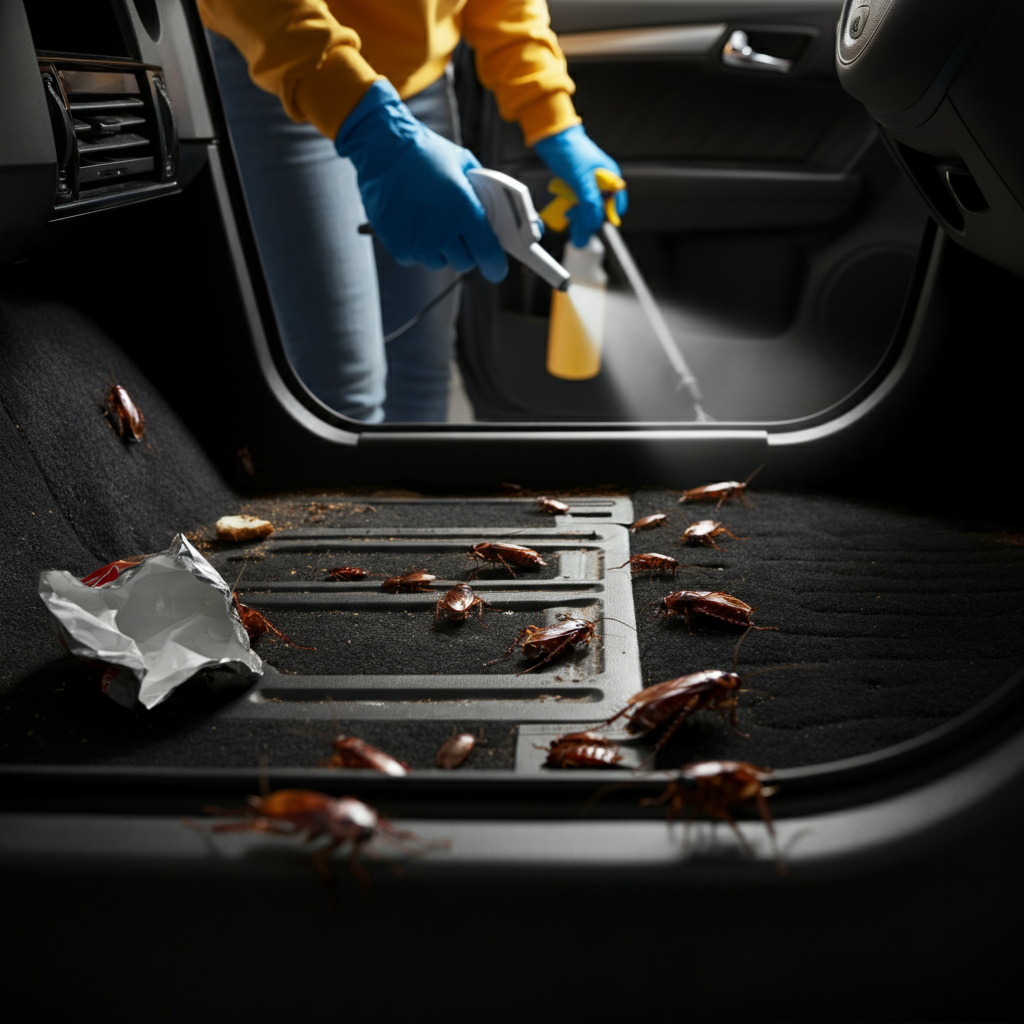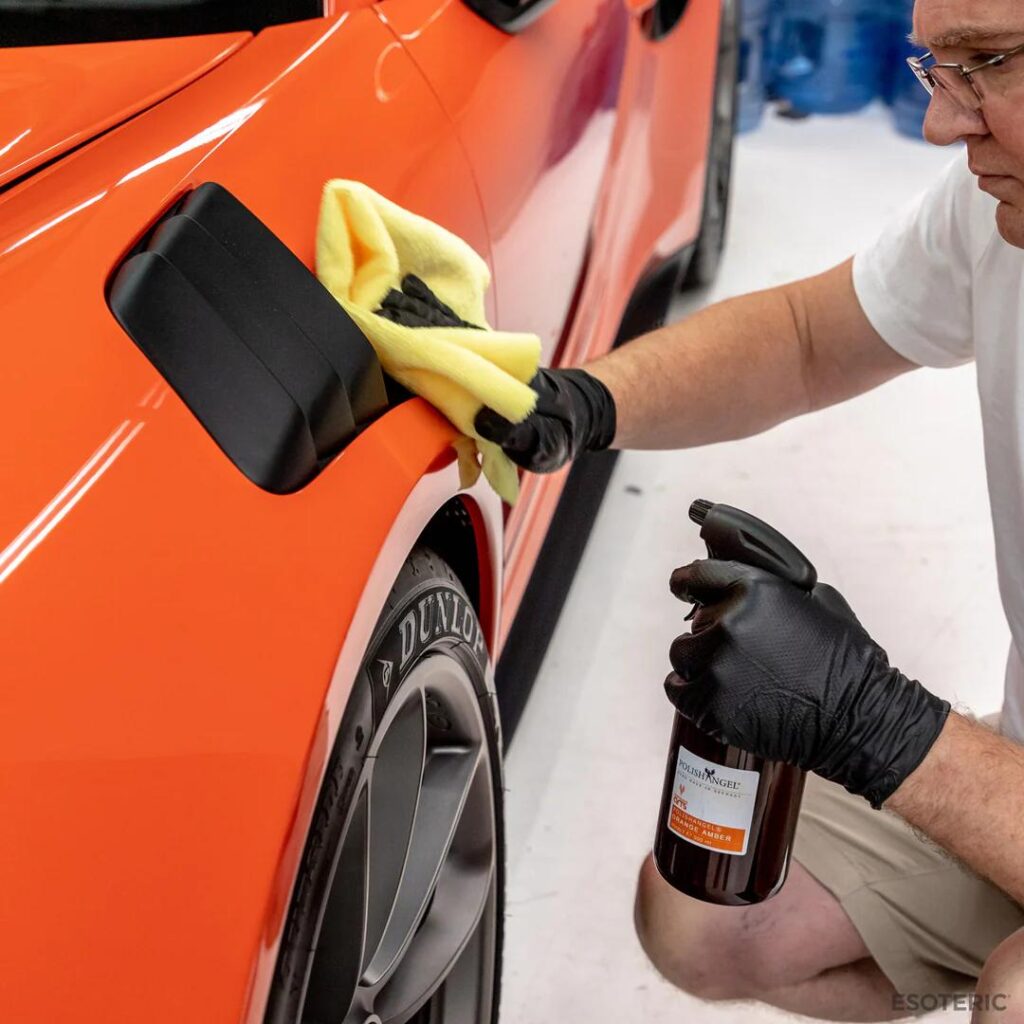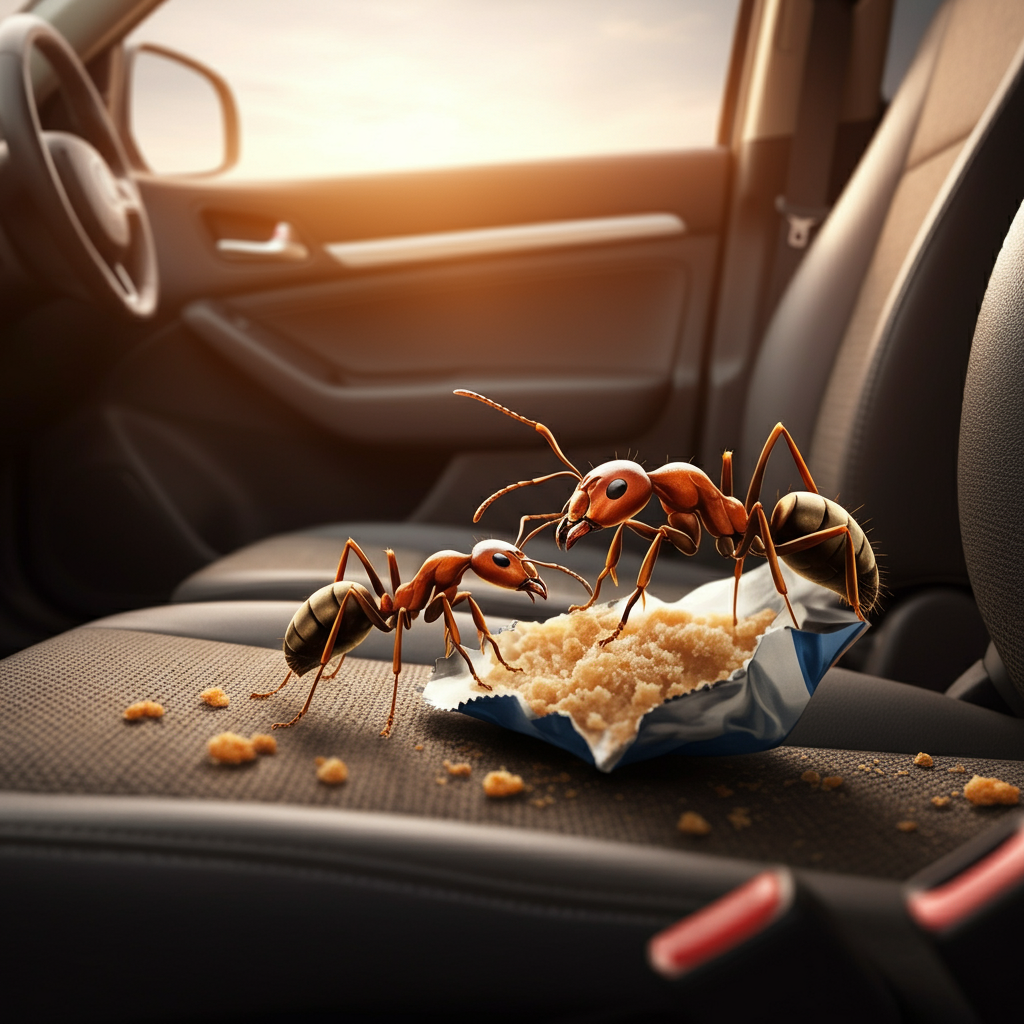As an Amazon Associate, I earn from qualifying purchases
Finding roaches in your car can be one of the most unsettling experiences for any driver. These resilient pests don’t just stay in homes—they can easily make their way into vehicles, creating an uncomfortable and unhygienic environment that no one wants to deal with during their daily commute.
Roaches in cars are more common than you might think. Your vehicle provides an ideal environment for these pests: dark hiding spots, potential food sources, and shelter from outdoor elements. Whether you’ve spotted a single roach scurrying across your dashboard or discovered clear signs of an infestation, taking immediate action is crucial to prevent the problem from escalating.
The good news is that eliminating roaches from your car is entirely achievable with the right approach and tools. This comprehensive guide will walk you through proven methods to remove these unwanted passengers from your vehicle and keep them from returning. From thorough cleaning techniques to effective treatment options, you’ll learn everything needed to reclaim your car and drive with confidence again.
Understanding why roaches target vehicles in the first place will help you tackle the problem more effectively and implement better prevention strategies for the future.
Table of Contents
Why Roaches Infest Cars
Roaches are drawn to cars for several compelling reasons that make vehicles surprisingly attractive to these adaptable pests. Understanding these factors will help you address the root causes and prevent future infestations.
Food sources are the primary attraction. Even the smallest crumbs from snacks, spilt drinks, or fast food can sustain roaches for extended periods. Food particles often fall between seats, under floor mats, and into cup holders, where they remain unnoticed but easily accessible to scavenging roaches.
Shelter and hiding spots make cars ideal roach habitats. Vehicles offer numerous dark, enclosed spaces that roaches prefer: under seats, inside door panels, within air vents, and behind dashboard components. These areas provide protection from predators and harsh weather conditions while remaining undisturbed for long periods.
Warmth draws roaches to cars, especially during cooler months. Engines generate heat that can make a parked car significantly warmer than the surrounding environment. This warmth extends to the passenger compartment, creating a comfortable microclimate that roaches find appealing.
Moisture from various sources can support roach populations. Spilt beverages, wet umbrellas, damp floor mats, or condensation from air conditioning systems create the humid conditions that roaches need to survive and reproduce.
Easy entry points allow roaches to access vehicles without difficulty. Open windows, doors left ajar, gaps around weatherstripping, or even hitching rides on clothing or bags can provide entry. Once inside, roaches can establish themselves quickly if conditions are favourable.
Cars parked near restaurants, garbage areas, or buildings with existing roach problems face higher infestation risks. Roaches can easily migrate from these locations into nearby vehicles, especially if attractive conditions exist inside the car.
How to Get Roaches Out of Your Car (Step-by-Step)

Successfully eliminating roaches from your car requires a systematic approach that addresses both visible pests and potential hiding spots. Follow these detailed steps to ensure complete removal.
Step 1: Clean Your Car Thoroughly
Begin with a comprehensive cleaning session that removes all food sources and debris that attract roaches. Remove everything from your car, including floor mats, seat covers, and personal items. Check each item carefully for signs of roaches or egg cases before deciding whether to clean or discard them.
Wipe down all surfaces using a disinfectant cleaner, paying special attention to areas where food or drinks might have spilt. Clean cup holders, door pockets, glove compartments, and centre consoles thoroughly. Use cotton swabs to reach tight spaces and remove accumulated debris.
Don’t overlook fabric surfaces. Clean seat upholstery, door panels, and carpeting with appropriate cleaners. Steam cleaning can be particularly effective for removing deep-seated odours and residues that might attract roaches.
Step 2: Vacuum All Areas, Including Hard-to-Reach Places
Vacuuming removes roaches, egg cases, and food particles that manual cleaning might miss. Use a vacuum with strong suction and various attachments to access different areas effectively.
Start with obvious areas like seats, floor carpets, and trunk space, then focus on harder-to-reach locations. Use crevice tools to vacuum between and under seats, around seat tracks, and along door frames. Pay attention to air vents, which can harbour roaches and their egg cases.
Remove and vacuum floor mats separately, checking both sides thoroughly. Vacuum inside door panels if possible, and don’t forget areas around pedals and under the dashboard where debris commonly accumulates.
Dispose of vacuum contents immediately in a sealed bag to prevent any surviving roaches from escaping back into your environment.
Step 3: Use Cockroach Baits or Traps
Strategic placement of baits and traps targets roaches that remain after cleaning. Gel baits are particularly effective because roaches consume the poison and carry it back to their hiding spots, potentially eliminating others in the colony.
Place small amounts of gel bait in areas where you’ve seen roach activity or droppings. Focus on dark, enclosed spaces like under seats, in door panel crevices, and around dashboard edges. Avoid placing baits where they might interfere with vehicle operation or create safety hazards.
Sticky traps can capture roaches and help monitor the extent of your infestation. Position traps under seats, in footwells, and other areas where roaches travel. Check traps regularly and replace them as needed.
Step 4: Apply Safe Insecticide Spray or Natural Remedies
Choose treatments appropriate for enclosed vehicle spaces where you’ll be breathing the air. Look for automotive-specific insecticides or natural alternatives that won’t damage car interiors or pose health risks.
For chemical treatments, select products labelled safe for automotive use. Apply according to manufacturer directions, focusing on cracks, crevices, and areas where roaches hide. Ensure adequate ventilation during application and allow proper drying time before using your vehicle.
Natural alternatives include diatomaceous earth (food-grade only), essential oil sprays, or boric acid powder. These options may work more slowly but pose fewer health and safety concerns. Apply natural treatments to areas where roaches travel, but avoid locations where the substances might interfere with vehicle operation.
Step 5: Repeat the Process If Necessary
Roach elimination often requires multiple treatment cycles, especially if dealing with a significant infestation. Monitor your car daily for signs of continuing roach activity, including live insects, droppings, or egg cases.
If you continue seeing roaches after initial treatment, repeat the cleaning and treatment process. Focus additional attention on areas where you’re still finding evidence of activity. Consider using different bait formulations or treatment methods if the first approach isn’t showing results.
Persistence is key to complete elimination. Some roaches may survive initial treatments, and egg cases can hatch weeks after adult roaches are eliminated, requiring ongoing vigilance and treatment.
Best Roach Prevention Tips for Your Car
Preventing roach infestations is far easier than eliminating established populations. These proactive strategies will help keep your car roach-free long-term.
Tip 1: Keep Your Car Clean and Tidy
Regular cleaning prevents the accumulation of food particles and debris that attract roaches. Vacuum your car weekly, paying attention to areas where crumbs and debris typically collect. Wipe down surfaces regularly with disinfectant to remove sticky residues and odours.
Address spills immediately rather than letting them sit. Even small amounts of spilt drinks or dropped food can sustain roach populations. Keep cleaning supplies in your car for quick cleanup of accidental spills.
Tip 2: Seal Cracks and Gaps in Your Car
Inspect your vehicle regularly for entry points that roaches might use. Check weatherstripping around doors and windows, ensuring it creates proper seals. Replace damaged weatherstripping promptly to eliminate gaps.
Look for cracks or holes in interior panels, especially around the dashboard and door areas. Use appropriate automotive sealants or tape to close these openings while maintaining vehicle functionality and appearance.
Tip 3: Remove All Food Sources
Establish a no-eating policy in your car, or if you must eat while driving, clean up immediately afterwards. Store any necessary food items in sealed containers that roaches cannot access.
Remove trash from your car daily, especially items containing food residues. Don’t leave fast food bags, drink containers, or snack wrappers in your vehicle overnight. Even empty containers can retain odours and residues that attract roaches.
Tip 4: Regularly Inspect Your Car for Roaches
Conduct weekly inspections for early signs of roach activity. Look for droppings, egg cases, shed skins, or unusual odours that might indicate roach presence. Early detection allows for prompt treatment before infestations become established.
Pay attention to areas where roaches commonly hide: under seats, in door panels, around dashboard edges, and inside air vents. Use a flashlight to examine dark areas thoroughly during inspections.
Natural vs Chemical Methods: Which Works Best for Roach Control in Cars?
Both natural and chemical approaches have advantages and limitations when dealing with car roach infestations. Understanding these differences helps you choose the most appropriate treatment method.
Chemical methods typically work faster and provide more reliable elimination of established infestations. Professional-grade insecticides and baits are specifically formulated to target roaches effectively. These products often provide longer-lasting protection and can eliminate entire roach colonies through secondary poisoning effects.
However, chemical treatments require careful consideration in vehicle environments. Enclosed car spaces can concentrate fumes, potentially creating health hazards. Some chemicals may also damage automotive surfaces or leave persistent odours that make driving uncomfortable.
Natural methods offer safer alternatives for people concerned about chemical exposure or environmental impact. Essential oils like peppermint, tea tree, or eucalyptus can repel roaches when applied regularly. Diatomaceous earth provides mechanical action against roaches without toxic effects on humans.
Boric acid, while technically a chemical, is considered relatively safe and highly effective against roaches. When applied properly in vehicles, it can provide excellent results with minimal risk.
The main limitation of natural methods is typically slower action and the need for more frequent reapplication. Natural repellents may prevent new infestations but might not eliminate existing populations as quickly as chemical treatments.
Combination approaches often work best. You might use natural methods for prevention while relying on targeted chemical treatments for active infestations. This strategymaximisess effectiveness while minimising chemical exposure.
Consider your specific situation when choosing methods. Light infestations might respond well to natural treatments alone, while heavy infestations typically require chemical intervention for effective elimination.
Frequently Asked Questions About how to get roaches out of car
Can roaches really live in my car?
Yes, roaches can definitely live in cars. Vehicles provide ideal conditions, including shelter, warmth, and potential food sources. Roaches can establish colonies in cars just as they do in homes, particularly in areas like under seats, inside door panels, and around dashboard components. Cars parked near infested buildings or restaurants face a higher risk of roach colonisation.
Are there any natural ways to get rid of roaches in my car?
Several natural methods can help eliminate roaches from cars. Food-grade diatomaceous earth sprinkled in roach hiding spots damages their exoskeletons. Essential oil sprays containing peppermint, tea tree, or eucalyptus oil can repel roaches. Boric acid powder, while technically a chemical, is considered a safer natural option that’s highly effective against roaches when applied to areas where they travel.
How long does it take to completely remove roaches from my car?
Complete roach elimination typically takes 2-4 weeks with consistent treatment. You might see dead roaches within days of initial treatment, but egg cases can take 2-6 weeks to hatch, requiring ongoing monitoring and retreatment. The timeline depends on infestation severity, treatment methods used, and how thoroughly you eliminate food sources and hiding spots.
If you’re also dealing with another pest in your car, like ants, you might find our guide on How to Remove Ants from Your Car useful. It provides similar steps and techniques for effective pest control in your vehicle.
Can I use regular home roach sprays in my car?
Most home roach sprays aren’t recommended for car use due to potential damage to automotive surfaces and concentrated fumes in enclosed spaces. Look for automotive-specific insecticides or natural alternatives designed for indoor use. Always ensure adequate ventilation when applying any treatment and allow proper drying time before using your vehicle.
What should I do if I still see roaches after following all steps?
Persistent roach activity after treatment usually indicates either incomplete initial treatment or ongoing attractants. Repeat the cleaning and treatment process, paying extra attention to areas where you’re still seeing activity. Consider using different bait formulations or consulting a professional pest control service if the problem persists. Sometimes professional-grade treatments are necessary for stubborn infestations.
Take Back Control of Your Vehicle
Eliminating roaches from your car requires patience, thoroughness, and the right approach, but it’s entirely achievable with consistent effort. The combination of deep cleaning, targeted treatments, and ongoing prevention strategies will restore your vehicle to a comfortable, pest-free environment.
Remember that successful roach elimination goes beyond just killing visible pests. Addressing the underlying conditions that attracted roaches initially—food sources, hiding spots, and entry points—is crucial for preventing future infestations. Regular maintenance and cleaning will keep your car inhospitable to these unwanted invaders.
If you’re dealing with a persistent infestation that doesn’t respond to these methods, don’t hesitate to consult professional pest control services. They have access to specialized treatments and can identify factors you might have missed. Your comfort and peace of mind while driving are worth the investment in professional help when needed.
As an Amazon Associate, I earn from qualifying purchases


